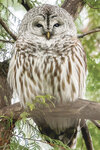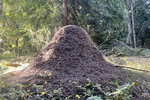

Last month my wife was attacked while running near our home in Lakebay.
It was dusk. She had just left the paved county road for a forest road when she felt something grab her hair and yank upward.
Then came a sharp rap to the top of her skull. She screamed and sprinted. In a split second the assailant vanished.
Strangely, wasps flashed through her mind. But it didn’t seem right. Now deeper in the woods, she faced the choice of running back to the county road, past the place where she had been attacked, or a much longer loop through rapidly darkening forest.
She chose the forest.
This time she saw it. A silent shape on outstretched wings passed directly over her head. It banked and came back toward her. She screamed again and dashed back to the road.
The owl did not follow.
Now we joke about running with bike helmets. We invent odd hypotheses: my wife’s ponytail looked like a scampering squirrel; her stride was light enough to sound like a rabbit’s leaps. Or maybe she entered the scene just as the owl was ready to swoop on some carefully stalked prey, and the owl was just fed up with oblivious people.
Perhaps that last one isn’t so far from the truth. Though it is rare, barred owls are known to swoop on people. It happened to a friend of mine in the Washington Park Arboretum. That they seldom draw blood, considering the damage they could do with beak and talons, seems to me pretty good proof that their goal is to frighten rather than fight. Kind of like most bears.
Barred owls, native to eastern North America, were first detected in western Washington in 1973 and have since flooded every forested habitat. I see them regularly at Gateway Park and at the Rocky Creek Conservation Area. If you’re in dense woodland, especially if water is around, barred owls are likely nearby. They perch in deep shade on tree limbs close to the trunk. They become active at dusk.
Lately they have grown infamous for tangling with and besting their close cousin, the spotted owl, which has been a figurehead for old-growth forest conservation since the bitter Nineties. Spotted owls, already confined to remnant patches of old-growth in the Cascades and Olympics, and far more specialized in their habits, have lost out wherever barred owls have appeared. Interestingly, barred owls made it to the Pacific Northwest on their own, hopscotching across the Midwest and Canada as forest fire suppression and tree-planting around human settlement created landscapes with the big, cavity-filled trees they need to nest and hunt.
Now a federal experiment is underway to cull barred owls in the remaining spotted owl strongholds. This has provided rich fodder for armchair ethicists: certain individuals of one species are being killed in order to save another species from disappearing entirely. It makes me ask: What is natural? What is just? Who is the arbiter? No matter how you slice it, people are at the root. Logging pushed spotted owls to the brink, and settlement ushered barred owls into new terrain.
Attacks like the one on my wife may be another pickle created by our intensifying land use. Find a barred owl and it may seem impassive, but if you act too curious it will leave. They don’t like to be around people. Shrinking patches of forest with more roads means more places where a barred owl, on the wrong day, might cross paths with an unsuspecting person.
On a Thatch Ant Superhighway
Well, it is September and harvestmen sit on squash leaves in my garden. In the bent-grass field edges, speedwell and beggarticks cheerily bloom, confounding the feeling I have been carrying that summer’s sun has long since baked every ounce of new flowering from the Earth.
On a walk in the woods, my son and I find an ant superhighway. They are thatch ants. This is the species that creates mounds of fir needles and twigs that can grow to three feet tall — often seen along quiet Key Peninsula roads through dry forest.
The ant trail crosses ours then runs along its edge for a good 530 feet. The ants, burnt red and black, run in both directions. Seeing one that carries a white morsel of food, we follow it. As it runs it bumps into ants coming the other way. At first this is funny. But it happens far too often to be an accident.
Ants live in a world of pheromones. The ants that first surveyed this superhighway also paved it with a trail of pheromones to guide their nestmates to what must be a food-rich patch of forest. When ants bump into each other, quick as a snap of your fingers, they tap antennae and gain a good sense of what lies ahead. For identification, not only of their species but their particular nest, they wear complex mixes of heavy pheromones like badges. To call for reinforcement in case of attack, they use volatile pheromones that disperse quickly. This species sprays formic acid.
Ants aren’t blind but they obey chemical signals over visual information. Experiments have shown again and again that ants deprived of their ability to sense pheromones behave as if completely lost. Vision alone cannot come close to sustaining their highly coordinated lifestyle.
Next we measure the ant’s speed. It completes an 8-foot dash in 50 seconds. For a quarter-inch ant, that’s 7.6 body-lengths per second. For us, that would be like running 15 miles per hour, a full sprint. These ants are traveling 25,000 body lengths each way. For us — our scribbled math spits out a beautiful answer — that would be a little over 26 miles, a marathon each way.
So, a sprinted marathon to find the day’s food and a sprinted marathon back, this time carrying a load for your family. And it’s quite a family. Thatch ants can have as many as 40,000 workers in a nest.
UNDERWRITTEN BY THE FUND FOR NONPROFIT NEWS (NEWSMATCH) AT THE MIAMI FOUNDATION, THE ANGEL GUILD, ADVERTISERS, DONORS AND PEOPLE WHO SUPPORT INDEPENDENT, NONPROFIT LOCAL NEWS